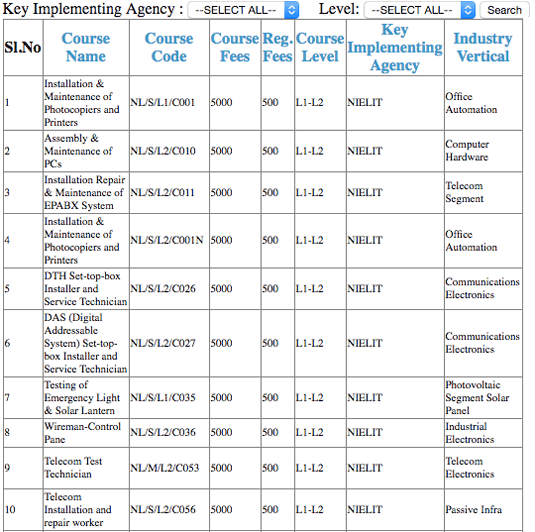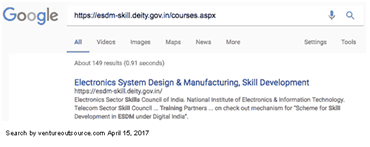The Make in India initiative is an ambitious attempt by Prime Minister Narendra Modi to turn India into a magnet for manufacturers, the aim being to increase the share of manufacturing in India’s GDP from a stagnant 15-16% since 1980 to 25% by 2022 and create an additional 100 million jobs.[1]
This is laudable, and its success—or otherwise—remains the subject of surveys and periodic assessments that suggest how it can be optimised better.
Yet, in many respects, India remains a problematic destination in some sectors. Several foreign electronics Original Equipment Manufacture (OEM) decision makers, seeking an Asian solution with Indian Electronics System Design and Manufacturing (ESDM)[2] solutions providers, find that not much has changed since 15 years ago, with their concerns continuing to pertain to a lack of infrastructure in the Indian electronics industry and over-promising by ESDM solutions providers, among others.
To put this in perspective, one measure of real electronics industry geoeconomic infrastructure is a commercial semiconductor wafer fabrication manufacturing facility: India still does not have one after many false starts over the years.[3]
Several other issues remain:
- Indian ESDM providers frequently claim they can fulfill any need of an electronics OEM prospect. Yet, they are slow to respond to customer concerns after the deal is signed, lack flexibility to programme change requests and have, at times, held programmes and programme moldings hostage when an OEM customer has decided to move to an alternative contract electronics solutions provider.
- Professionalism issues persist, such as Indian ESDM senior executives arriving late for scheduled meetings–or not at all—or trying to reverse engineer or obtain competitive intelligence from customer OEM programmes already in partnership.
- Unreliable communications channels lead to poor dialogue quality and dropped connections.
OEM decision makers often obsess over these issues which are critical to their industry. Executives already face many risks, including work stress, time and budgetary constraints, and worry about their reputation among colleagues. What if the electronics solutions provider(s) selected cannot deliver on their promises? Moving OEM programmes to other providers is costly, both in terms of money and lost opportunity costs, and can lead to declining market share for an OEM product.
Failed OEM company efforts continue to remind OEMs of the desire for India to become a global ESDM player. This is approaching a critical point as the decision on whether or not a company can be profitable sourcing its ESDM solutions in India has to be taken without prolonged deliberation.
Success is India’s to lose. The country is home to the last great emerging market; its middle class and purchasing power will grow in the coming years. But it cannot rely on the importance of OEMs to locate electronics manufacturing too close to their base of product consumption if word-of-mouth reputation of the Indian ESDM industry continues to spread among OEM decision makers worldwide.
There are plenty of alternative Asian ESDM destinations, including Indonesia, Philippines, Vietnam, and Malaysia, while China remains attractive, with its mature supply chain infrastructure in place despite the growing costs of labour. Wages are a small portion of the materials cost of goods sold for most electronics items being manufactured across Asia, and therefore, India’s wages are typically not suitable to offset the negative impact or cost of running lower manufacturing volumes.
Meanwhile, the Philippines and other destinations already compete with India on labour rates, intellectual property protection, various engineering capabilities and pricing of services. Also, some of these nations have considerably more competitive import duties for bringing in expensive capital equipment.
Also, few Indian ESDM factories have the upside capacity relative to many other Asian contract electronics regions, partially driven by low volumes of electronics items demanded domestically, but this could change as the wealth GDP redistribution that James Wolfensohn defines takes hold.[4]
No doubt things are different this time for India because of concerted efforts from New Delhi, electronics industry trade bodies, organisations, and policy-making institutions. These professional and government bodies regularly review both individual and cohesive strategy to enhance and promote electronics hardware design and manufacturing capability, and services, like the newly formed Ministry of Electronics and Information Technology (MeITY), the Manufacturers’ Association for Information Technology (MAIT), the Electronic Industry Association of India (ELCINA), Confederation of Indian Industry (CII), and other both well-worn and new initiatives, such as Digital India, Make in India, and Invest India.
Many of India’s national policy changes have also included changes to Preferential Market Access (PMA) policies, schemes for Modified Special Incentive Packages (M-SIPS) and Electronics Manufacturing Clusters (EMC) as also various taxation and electronics product segment-specific initiatives included in the 2014-2015 budget[5], each designed to foster both foreign and domestic investments while reducing constraints related to internal economic growth.
Such changes apart, India’s electronics manufacturing companies require sustainable supply chain ecosystems and reliable, uninterrupted power or energy regardless of geography. Also required is ESDM leadership development: based on interactions with hundreds of Indian managers and executives across dozens of Indian ESDM firms over the years, it’s clear that a broader base of qualified, ESDM decision-making managers across all functional groups needs to be cultivated further.
There are some efforts and signs of progress being made, but signs of weakness exist. The Indian Ministry of Electronics & Information Technology had over 400 courses listed on its website[6] for training and jobs in India’s ESDM industry. However, coursework focused only on activity-based technical capabilities. See Figure 1. (Results of a Google cache search conducted 15 April 2017.)

The ESDM courses listed above are through the government of India’s National Institute of Electronics & Information Technology (NELIT). Other organisations listed on the website that offer courses include, the Noida Productivity Council, NIT India, and Enize Infotech, to name a few.
Several months ago I emailed a few organisations offering ESDM courses on the site, and asked each if they could share some details to help quantify how someone paying for their course(s) might be able to further enhance their ESDM professional career capabilities that India was offering to the world.
I received one response from NIT, thanking me for my inquiry, informing me someone would follow up, but no one did.
Surprisingly, there were no ESDM soft skills or managerial leadership development courses specific to the ESDM field available, such as ESDM programme management and line of business management and ESDM functional group management decision-making.
Similarly, ESDM leaders in India must also know how to quote new customer opportunities while understanding ESDM business unit finances, balance sheets, profit and loss and cash flow statements to run profitable ESDM businesses.
A Google search for the ESDM courses available when I first began researching this paper returned a message, saying that the server DNS address could not be found when clicking through: https://esdm-skill.deity.gov.in/courses.aspx/

Leading India by example
India has been undergoing a long startup phase toward building ESDM prominence, and the opportunity for it to be a hotspot for sourcing electronics solutions continues to hold promise for foreign OEM decision makers in light of recent changes in government personnel. Or as World Bank president Jim Yong Kim said to reporters in New Delhi in June 2016, “I am a big fan of Prime Minister Modi and the reason I’m such a big fan is because he does something that all great leaders should do, that is set ambitious targets, set deadlines for those targets and then hold your staff accountable for those targets. That is tried and proved method of getting results.”[7]
Even Arun Shourie, one of Modi’s most outspoken critics, has praised the prime minister’s ability to curtail government corruption. In a 2016 interview on India TV, Shourie credited Modi with “drastically reduced corruption, [and] that there hasn’t been a single case of corruption in the government and that nobody in the Modi Cabinet can be accused of corruption”.[8]
While this is encouraging, there is a need for coordination and cooperation with national and regional Indian ESDM businesses. India must still continue to promote:
- “Partnerships and foreign technology-based venture capital investments in ESDM industry start-up and incubation ventures;
- Corporate rewards for the private sector to play an active role in producing a continuous stream of innovative ESDM business ideas and models conducive to the dynamic Indian environment and socioeconomic development;
- Effective communication of the relative laws and enforcement measures that ensure strict implementation of IP rights to fuel innovation;
- Adequate attention to upgrading basic ESDM-related technical infrastructures and better access for links to knowledge sources and international industry networks”[9]
- Collaboration with the private sector, especially on vocational training, critical thinking and defining skill sets for the industry.[10]
If new government initiatives are neglected, more effective ESDM industry leadership training and professional development are ignored and, dishonourable business practices are allowed an environment to thrive in, the best efforts by India in placing a stamp on the Indian ESDM industry could be wasted.
Mark Zetter is CEO of VentureOutsource.com. You can find him on LinkedIn here.
This article was exclusively written for Gateway House: Indian Council on Global Relations. You can read more exclusive content here.
For interview requests with the author, or for permission to republish, please contact outreach@gatewayhouse.in.
© Copyright 2017 Gateway House: Indian Council on Global Relations. All rights reserved. Any unauthorized copying or reproduction is strictly prohibited
References
[1] Ministry of Finance, Government of India, Economic Survey 2015-2916: Economic Outlook, Prospects, and Policy Challenges, February 2016, pp. 35-36, <http://indiabudget.nic.in/es2015-16/echapvol1-01.pdf>; Planning Commission, Government of India, Report of the Working Group on Information Technology for the Formulation of the Tenth Five Year Plan, November 2001, <http://planningcommission.gov.in/aboutus/committee/wrkgrp/wg_it.pdf>
[2] National Institute of Electronics & Information Technology, Ajmer, Ministry of Electronics & Information Technology, Government of India, Services: ESDM, <http://beta.nielit.gov.in/ajmer/content/esdm-electronics-system-design-and-manufacturing-scheme>
[3] Sharma, Himank, “India dials back chip ambitions as investors spurn plant funding”, Reuters, June 15, 2016 <http://in.reuters.com/article/us-india-semiconductor-idINKCN0Z10XR>; Zetter, Mark, “Economic drivers, challenges creating regional electronics industry”, Venture Outsource, <https://www.ventureoutsource.com/contract-manufacturing/benchmarks-best-practices/executive-management/economic-drivers-challenges-creating-regional-electronics->
[4] Former World Bank President: Big Shift Coming, James Wolfensohn, 2010, Stanford Graduate School of Business, Youtube video, <https://www.youtube.com/watch?v=6a0zhc1y_Ns>
[5] India Electronics & Semiconductor Association, Impact of Recent Policy Developments on Disabilities of ESDM Sector, January 2015, <http://www.iesaonline.org/downloads/Impact_of_recent_policy%20developments_on_disabilities_of_ESDM_sector.pdf>
[6] Ministry of Electronics and Information Technology, Government of India, Skill Development: Electronics System Design and Maufacturing: Courses, <https://esdm-skill.deity.gov.in/(S(xe2qmxravc1ojfncq3scb4wl))/courses.aspx>
[7] “India under Modi has been fantastic: World Bank president”, Hindustan Times, 30 June 2016, <http://www.hindustantimes.com/business-news/india-under-modi-has-been-fantastic-world-bank-president/story-K9nHgPakA0r0QBmEANRU0N.html>
[8] Singh, Ashok K., “Why Shourie Is Right in Praising Modi’s Fight Against Corruption,” First Post, 10 May 2016, <http://www.firstpost.com/india/arun-shourie-pm-modi-fight-against-corruption-2772698.html>
[9] Zetter, Mark, “Steps for India to succeed in electronics services design manufacturing (EDSM)”, Venture Outsource, 25 November 2014, <https://www.ventureoutsource.com/contract-manufacturing/outsourcing-offshoring/india-manufacturing/steps-to-develop-and-promote-indian-ems>
[10] Ibid


